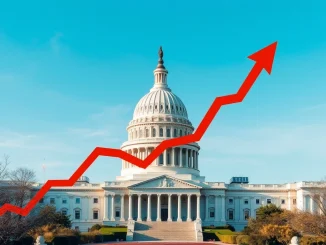
Get ready for a major shift in the financial landscape! A recent report from the American investment bank JPMorgan has dropped a significant forecast for the future of the stablecoin market. This isn’t just another crypto prediction; it comes from a global financial heavyweight, suggesting that stablecoins are poised for substantial expansion.
JPMorgan Stablecoin Forecast: What Did They Say?
According to the analysis by JPMorgan stablecoin market size could see tremendous stablecoin growth in the coming years. The report estimates the market could swell to somewhere in the range of $500 billion to $700 billion. This forecast, initially reported by Zerohedge via X, signals a belief within traditional finance that stablecoins are moving beyond niche crypto use cases and into mainstream finance.
The implications of this projected growth are far-reaching. JPMorgan analysts specifically highlighted one fascinating potential outcome related to US debt.
Stablecoin Growth and Its Impact on US Treasuries
One of the most striking points in the JPMorgan report concerns the potential influence of stablecoin issuers on the market for US Treasuries. Stablecoins, particularly those pegged to the US dollar, typically hold reserves to maintain their peg. These reserves often consist of safe, liquid assets.
JPMorgan analysts crunched the numbers based on a common reserve strategy:
- 70% invested in U.S. Treasuries
- 30% invested in Treasury repos (repurchase agreements)
If the stablecoin market reaches the predicted $500 billion to $700 billion size, holding reserves in this manner could make stablecoin issuers collectively the third largest holder of U.S. Treasuries globally. This puts them behind only the Federal Reserve and foreign governments.
Why does this matter?
- Increased Demand: A larger stablecoin market means potentially billions more dollars flowing into U.S. government debt, providing a consistent source of demand.
- Market Influence: As major holders, stablecoin issuers could gain influence or be impacted by shifts in Treasury market dynamics.
- Integration of Crypto and Traditional Finance: It further blurs the lines between the digital asset world and conventional bond markets.
Why is the Stablecoin Market Expanding?
The projected stablecoin market expansion isn’t happening in a vacuum. Several factors are contributing to their increasing adoption and utility:
- Stability: Unlike volatile cryptocurrencies like Bitcoin or Ethereum, stablecoins aim to maintain a stable value, usually pegged to a fiat currency like the USD. This makes them suitable for transactions, savings, and as a safe haven within the crypto ecosystem.
- Payments and Remittances: Stablecoins offer a faster, cheaper, and more accessible way to send money globally compared to traditional systems.
- Decentralized Finance (DeFi): Stablecoins are the backbone of much of the DeFi ecosystem, used for lending, borrowing, and trading on decentralized platforms.
- Institutional Interest: More institutions are exploring stablecoins for various purposes, including settlement and trading.
- Regulatory Clarity (Emerging): While still evolving, regulatory frameworks for stablecoins are beginning to take shape in various jurisdictions, potentially increasing confidence and adoption.
Potential Impact on the Crypto Market Forecast
This bullish crypto market forecast from JPMorgan, specifically concerning stablecoins, is a positive signal for the broader digital asset space. It suggests that a major player in traditional finance sees tangible value and significant growth potential in a key component of the crypto ecosystem.
Increased stablecoin adoption can lead to:
- More liquidity within crypto exchanges and platforms.
- Easier on-ramps and off-ramps between fiat and crypto.
- Greater overall participation in the digital asset economy.
While stablecoins themselves aim for price stability, their growth contributes to the infrastructure and utility of the entire crypto market.
What’s Next for Stablecoin Growth?
While the forecast is optimistic, the path to $700 billion isn’t without potential hurdles. Key factors to watch for future stablecoin growth include:
- Regulation: How governments worldwide choose to regulate stablecoins will significantly impact their design, issuance, and adoption. Clear, sensible regulation could accelerate growth, while overly restrictive rules could hinder it.
- Competition: The stablecoin landscape is becoming more competitive, with new issuers and even central banks exploring Central Bank Digital Currencies (CBDCs).
- Technological Development: Continued innovation in blockchain technology will be needed to handle the transaction volume required for mass adoption.
- Public Perception: Building trust and understanding among the general public and businesses is crucial.
The JPMorgan forecast is a powerful indicator that stablecoins are no longer just a crypto curiosity. They are evolving into a significant force with the potential to impact global finance, including something as fundamental as the market for U.S. government debt.
Conclusion: Stablecoins Stepping Onto the Global Stage
JPMorgan’s prediction of the stablecoin market potentially reaching $500 billion to $700 billion within a few years is a landmark forecast. It underscores the growing importance and potential of stablecoins not just within the crypto world but in the broader financial system. Their increasing demand for U.S. Treasuries as reserves highlights a fascinating intersection between digital assets and traditional government debt. As stablecoins continue their rapid evolution, their impact on payments, finance, and even sovereign debt markets will be a critical trend to follow.



